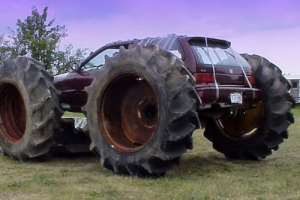Can You Change Tire Size on the Same Rim
How Do I Safely Upsize the Wheels On My Car?
 With low profile tires being all the rage, moving to a bigger wheel is an like shooting fish in a barrel way to update the await of your machine. It can too improve performance: A shorter sidewall flexes less while the vehicle is making turns, thus maintaining grip, while a wider tire improves lateral stability. Switching to a bigger bike tin can open up a wider selection of compatible tires, especially functioning models.
With low profile tires being all the rage, moving to a bigger wheel is an like shooting fish in a barrel way to update the await of your machine. It can too improve performance: A shorter sidewall flexes less while the vehicle is making turns, thus maintaining grip, while a wider tire improves lateral stability. Switching to a bigger bike tin can open up a wider selection of compatible tires, especially functioning models.
However, at that place are some tradeoffs: Tires are lighter than wheels, so equally bike size goes upwardly, so does weight. This negatively impacts fuel economy and acceleration and makes the steering heavier. The shorter sidewall also provides less cushion, giving the car a harsher ride.
How big can I go?
If the new wheels and tires are bigger than the originals, the tires may rub against the fender well when making tight turns or when the suspension bottoms out. Speedometers calculate speed by determining the distance traveled for each wheel rotation, and then a size alter tin brand the reading inaccurate. To go on the suspension and speedometer functioning correctly, both the stock diameter and width of the wheels and tires needs to be maintained.
As a general rule of pollex, information technology's safe to fit a tire upward to 20 millimeters wider than stock on the original rim. The actual width of the tire will vary depending on the width of the rim: The tire volition expand v millimeters for every half inch (12.5 millimeters) increase in rim width.
Moving to a unlike rim gets a piffling more complicated because tire sizes are a combination of metric and percent measurements, while wheel sizes are in Imperial measurements.
For example, the motorcar currently has 225/45R15 tires. Here'due south what that means:
- 225 – Tire width in millimeters
- 45 – Sidewall height equally a percent of tire width
- 15 – Rim diameter in inches
To convert the cycle size into millimeters, multiply by 25.4:
- 15 inches x 25.4 = 381 millimeters
Next, calculate the sidewall acme past multiplying the tire width by the summit pct:
- 225 millimeters 10 0.45 = 101.25 millimeters
Add the two numbers together, to get the full tiptop of the wheel and tire:
- 381 + 101.25 = 482.25 millimeters
To keep speedometer error in line, the new tire and wheel should be inside 3 percent of the original combination's height. Moving to a xvi inch (406.4 millimeters) rim would require a tire with a summit of 75.85 millimeter, 34 pct of the 220 millimeter width, or 220/34R16. The closest size manufactured is 220/30R16, which is well inside the 3 percent size margin.
Source: https://www.goldeagle.com/tips-tools/how-do-i-safely-upsize-the-wheels-on-my-car/
0 Response to "Can You Change Tire Size on the Same Rim"
Post a Comment